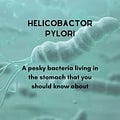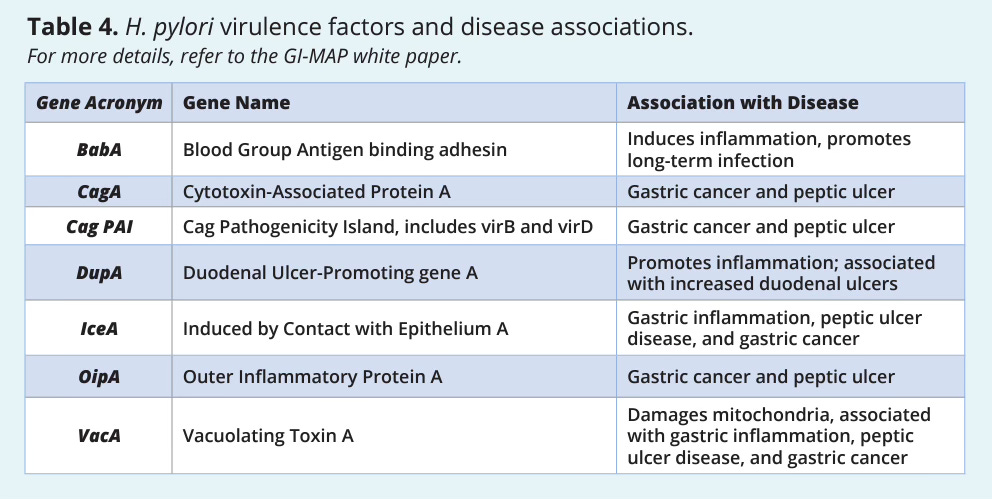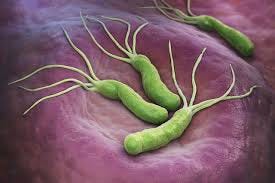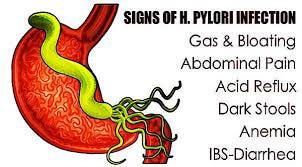In 2018 Diagnostic Solutions Lab released the GI Map Advanced Stool Test. H.Pylori bacteria testing in the past has been known for false negatives so with the 97% accuracy of this test as well as a listed separate diagnostic of the presence of “Virulence Factors”, we can now see its invasiveness via 7 virulence factors. This is vitally important as you can see below - as each virulence factor is associated with specific disease -
What is h.Pylori? From cancer.gov:
“H. pylori is a spiral-shaped bacterium that grows in the mucus layer that coats the inside of the human stomach. Although many bacteria cannot survive the stomach’s acid environment, H. pylori is able to neutralize the acidity of its local environment in the stomach, though not the stomach as a whole. This local neutralization helps the bacterium survive.
Another way H. pylori survives in the stomach’s acidic environment is by burrowing into the mucus layer and attaching to the cells that line its inner surface. This also helps it avoid immune destruction, because even though immune cells that normally recognize and attack invading bacteria accumulate near sites of H. pylori infection, they are unable to reach the stomach lining. H. pylori also interferes with local immune responses, making them ineffective in eliminating this bacterium…”
H.Pylori is shaped like a small corkscrew that burrows deep into the intestinal wall. It releases Urease, which changes the pH of the gut so it can survive. When you are told that your stomach is ‘too alkaline’ and you ‘need more acid’, it can be a big sign that might be carrying this bacteria. Urease testing & detection is a significant indicator of an h.Pylori infection (other symptoms - lack of acidity, chronic heartburn and chronic gastritis pain). Here’s a great article on how a H.Pylori infection controls the gut - “Helicobacter pylori is unique in its capacity to efficiently colonize the acidic gastric environment….” - (link) How does H.Pylori Control Urease Activity?
H.Pylori has been associated with peptic ulcer disease, dyspepsia, idiopathic thrombocytopenic purpura, iron deficiency anemia, low-grade gastric mucosa-associated lymphoid tissue (MALT) lymphoma, and gastric adenocarcinoma in all sites. In the last few years there has been increasing evidence that there is a link between h.Pylori infection and gallbladder and biliary tract disease - (link) - Link Between h.Pylori infection & gallbladder/biliary tract disease
Some publications claim that h.Pylori is not always harmful and can actually be helpful for the gut. Asymptomatic carriers seem to be ‘unaffected’? - But dare I ask - even if they are asymptomatic can they still pass it? And what if it is passed to someone who is immune compromised?
A general internet search will confirm contagious transmission:
Saliva: H. pylori is commonly transmitted through saliva.
Fecal contamination: The bacteria can contaminate food or water through feces.
Kissing: H. pylori can be spread through kissing.
Hand contact: H. pylori can be transferred from someone who hasn't washed their hands after using the restroom.
Sharing utensils: Sharing eating utensils with an infected person can spread H. pylori.
Another way of contagion which is not often discussed is the nosocomial transmission of h.Pylori bacteria via endoscopy. The endoscopes are not always properly decontaminated.
Classic Symptoms of h.Pylori:
Abdominal Pain/Digestive issues
Chronic Gastritis
Acid Reflux/Heartburn
Anemia
Bad Breath
Bloating & Excessive Gas
Chest Pain & Pain between the shoulder blades
Constipation and/or Diarrhea
Gastritis
Nausea & Vomiting
Ulcer
Anemia
Rosacea/Skin Problems
Autoimmune Disorders
Classic Treatment
Because so many people are infected with this bacteria and doctors do not understand the intricate balance of the biome - more damage is done with typical treatments: antibiotics and/or corticosteroids and PPI’s (proton pump inhibitors) the ‘Z-Pack’. Many times the use of PPI’s can make the h.Pylori impossible to find on testing later - even if it is still an active infection. When the patient returns to the doctor complaining of the same symptoms the doctor tells them its all in their head because the test results show nothing. If the patient persists the doctor will then say: “everybody has it, don’t worry about it”, but as we have seen above with the virulence factors, not all h.Pylori is the same. The 3 drugs most doctors use do not get to root cause and actually destroy the ecosystem - they do not cause healing but defeat the entire purpose. Furthermore, h.Pylori rarely lives alone. It thrives with other bugs like Blastocystis Hominis and Candida Albicans (yeast/fungus). The typical drug/Pharma suppressing treatment will increase candida growth (antibiotics), affect healthy digestion and elimination via the loss of good bacteria and affecting other organs like the liver. For about 6 weeks the person treated with the Pharma drugs might feel better but then h.Pylori comes roaring back - and THIS TIME it is stronger. The next time or the next time after that the drugs will do nothing. I’ve worked with people where their h.Pylori came back up to 6x. To destroy it and heal you must get to the entire gut itself… or in the words of Antoine Béchamp, remember- “The Terrain is Everything”.
Natural Treatment
For eradicating H. pylori using natural means - remember that your diet matters. Inflammatory foods/Processed foods must be removed. This includes restaurant foods as they are almost always cooked in refined/seed oils. Sugar, alcohol, gluten, dairy are also classic removals. For Keto or Paleo choose an ‘AIP keto’ (autoimmune) protocol. Carnivore is also good.
A natural antimicrobial I like is Matula Tea. Its very pricey but Matula Herbal Tea is effective at killing off 93% of Helicobacter pylori each and every time that Matula comes into contact with Helicobacter pylori in your digestive system. This is almost unheard of utilizing any other product. You must order at www.MatulaTea.com- it is nowhere else.
Other antimicrobials are Mastic Gum, Black Cumin Seed and/or Allicin (garlic extract). A biofilm disruptor like Allergy Research Group Biofilm Neutralizer - Biofilm Defense, taken up to 90 days seems to work well. Certain probiotics have been found to be a great help - the L. reuteri DSM 17648 strain has been studied for its ability to reduce H. pylori load. This strain surrounds H. pylori without negatively impacting commensal gut bacteria. Saccharomyces Boulardii probiotic is also found to be helpful.
Both Gluten Intolerance and h.Pylori infection can cause anemia and yet both are rarely tested for. People are told their symptoms are ‘nothing’ and ‘everybody has it’ for FAR too long. It is more than time for doctors to get to root cause with so many people being health compromised and in chronic health distress. H.Pylori is one of the most foundational gut issues that must be resolved for all other issues - digestive and eliminative to be resolved.
I appreciate each and every reader - I’m on Twitter as Wejolyn, and on YouTube as Nethersprings Nutrition & Health Coaching. Im also at www.nethersprings.com
Wendy McPhail, CNC, NBCCT, FDN
ADAPT Functional Health Coach
Weston A. Price Local Chapter Leader








This is so interesting. I tested negative for this but have all the symptoms. I’m going to try the tea option and report back.
'H.Pylori has been associated with peptic ulcer disease, dyspepsia, idiopathic thrombocytopenic purpura, iron deficiency anemia, low-grade gastric mucosa-associated lymphoid tissue (MALT) lymphoma, and gastric adenocarcinoma in all sites'.
In other words, the bacteria is the result of the condition.
Bacteria are janitors.
There is not one she'd of evidence that proves bacteria cause disease.
Not one study that uses purified bacteria to replicate a disease in a host.